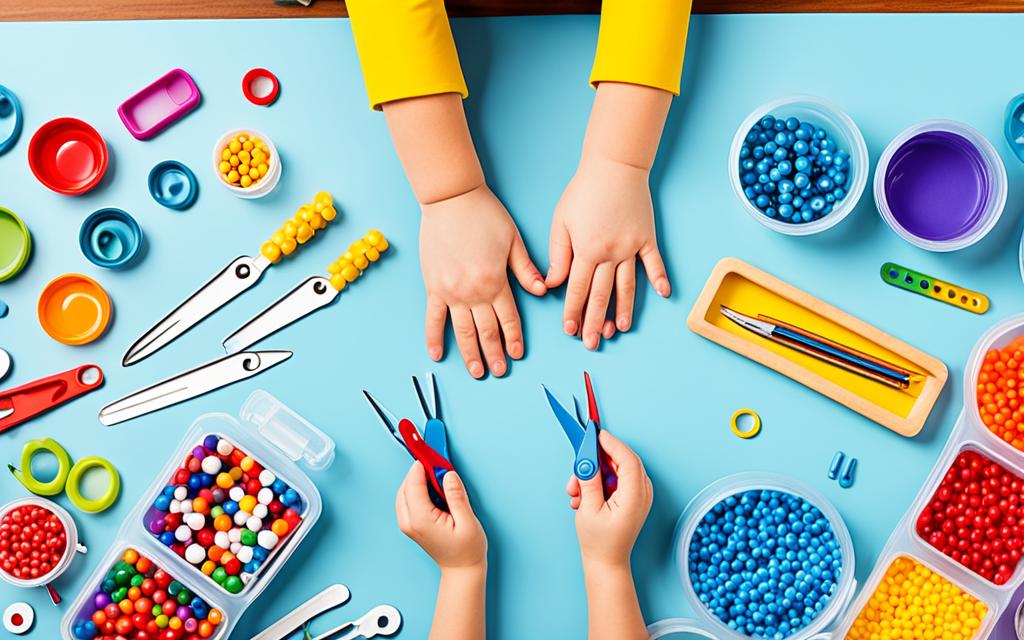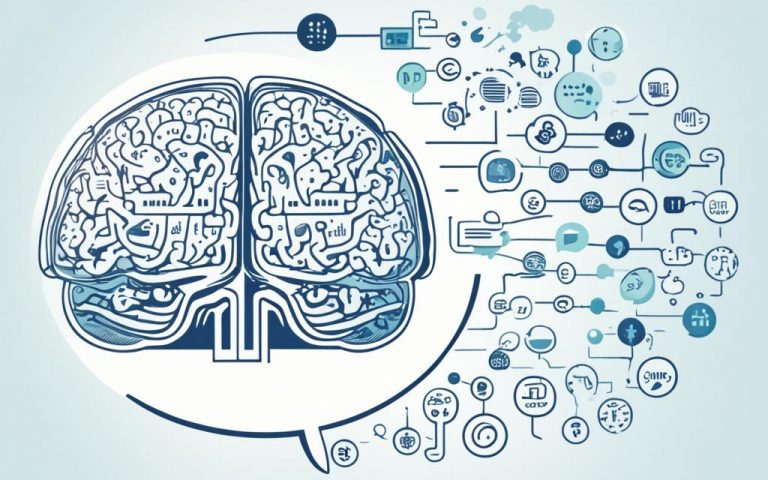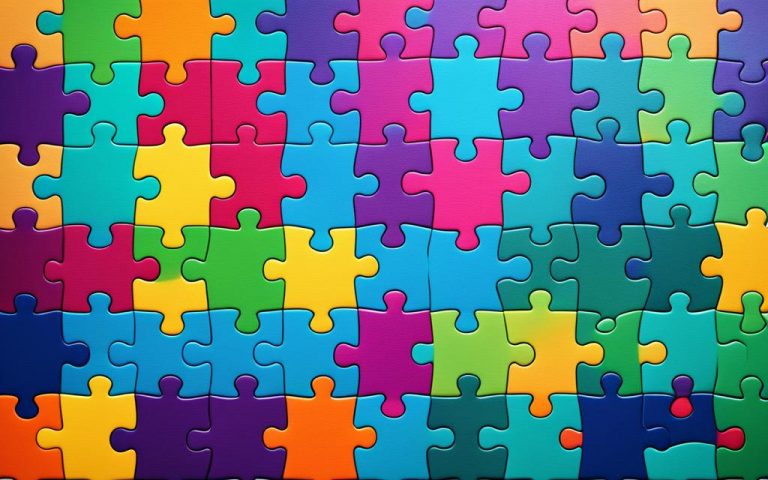Hand Therapy for Child Fine Motor Skill Growth
As a parent in the United Kingdom, you’re likely invested in your child’s developmental progression, seeking to enhance their capabilities through effective paediatric rehabilitation. Understanding the impact of motor control on your child’s ability to navigate the world is pivotal. Hand therapy offers significant benefits for children, with tailored interventions designed to bolster fine motor skills—those detailed movements that manipulate the environment around them, ensuring their growth tracks along a promising trajectory.
Key Takeaways
- Hand therapy is key to fostering children’s fine motor skills for daily tasks such as writing and self-care.
- Paediatric rehabilitation focusing on hand therapy can immensely support a child’s developmental progression.
- Motor control is essential for your child’s academic and social successes, forming the foundation of their ability to learn and interact.
- Professional guidance in hand therapy can address developmental delays and encourage sensory integration.
- The benefits of hand therapy for children are vast, ranging from improved dexterity to enhanced confidence in their functional abilities.
Understanding Fine Motor Skills in Children
As you delve into the facets of children’s development, the intricacies of fine motor skills come to the forefront, especially during the early stages of growth. These abilities are fundamental as they form the building blocks for more complex tasks that your child will encounter throughout their life.
Defining Fine Motor Development
Fine motor development is characterised by the gradual enhancement of fine motor skills, which involves the refined use of the small muscles in the child’s hands and wrists. These muscles play a crucial role in enabling actions such as pinching, grasping, and manipulation of objects, paving the way for essential life skills including writing, dressing, and even self-feeding.
The Importance of Strong Motor Control in Early Childhood
The significance of early childhood motor control cannot be overstated. It lays the groundwork for sensory integration, which is the process by which children learn to interpret and respond to the sensory stimuli around them. A firmly established motor control serves as a cornerstone for cognitive and social development, ensuring that children have the capacity to engage with their surroundings in a meaningful and productive manner.
| Age | Expected Fine Motor Milestones | Activities to Support Development |
|---|---|---|
| 0-6 months | Reaches and grasps objects | Tummy time, playing with rattles |
| 6-12 months | Transfers objects from one hand to another | Playing with blocks, stacking rings |
| 1-2 years | Builds a tower of blocks, starts to scribble | Drawing with crayons, simple puzzles |
| 2-3 years | Manipulates small objects and begins using scissors | Stringing beads, cutting with child-safe scissors |
| 3-4 years | Develops a tripod grip and copies simple shapes | Drawing shapes, modelling clay activities |
| 4-5 years | Writes some letters and dresses independently | Practice writing, buttoning clothes |
By identifying any potential deficits in fine motor skill milestones at an early juncture, you can enable interventions that may be critical in setting children up for success in educational and recreational activities.
The Role of Hand Therapy in Paediatric Rehabilitation
As a cornerstone of paediatric rehabilitation, hand therapy offers a bespoke approach to aiding young individuals in overcoming the challenges that come with various developmental impediments. Being well-versed in the goals of hand therapy enhances your awareness of how this treatment can shape the progress of children in your care, especially in terms of enhancing their ability to interact with the world around them through improved sensory integration.
Goals of Hand Therapy for Young Patients
The objectives of hand therapy in paediatric settings are multifaceted, striving to boost a child’s functionality in day-to-day tasks. Fundamental milestones include augmenting grip strength, refining dexterity for fine motor tasks, and nurturing hand-eye coordination. Such therapies are intricately designed with the aim of merging sensory feedback with motor execution, thus forming a cohesive process that supports a child’s interaction with their environment.
Who Benefits from Hand Therapy?
Hand therapy is instrumental for children experiencing various ranges of developmental delays, those who have been diagnosed with neurological disorders, and young patients recuperating from injuries. Rather than a one-size-fits-all approach, this therapy is tailored to meet the individual needs of each child, thereby ensuring they derive the greatest benefit from their rehabilitation journey.
| Condition | Benefits of Hand Therapy | Notes |
|---|---|---|
| Developmental Delays | Enhanced fine motor skills, improved coordination | Crucial for early intervention |
| Neurological Conditions | Improved sensory perception, hand function | Therapy adapted to specific neurological needs |
| Post-Injury | Restoration of hand strength and flexibility | Supports return to daily activities |
Hand Therapy – Supporting the Development of a Child’s Fine Motor Skills
Developing children’s fine motor skills is vital for their mastery of tasks such as writing, buttoning, and using cutlery. Development support for these critical skills often necessitates special intervention. Hand therapy techniques play a significant role in improving the dexterity and coordination required for children to perform such tasks with ease. By engaging young patients in various activities and exercises, therapists dedicated to paediatric care enhance motor skills development extensively.
These therapeutic approaches not only bolster motor functions but also imbue children with a sense of achievement, often translating to motivation in their daily lives. Tailored therapy sessions encourage perseverance and creativity, laying down a pathway to greater independence and self-reliance. Below we outline some common hand therapy techniques and activities that contribute to the fine motor skills development in children.
- Play-based therapy to improve grip and control
- Theraputty exercises for strengthening hand muscles
- Craft activities that enhance hand-eye coordination
- Interactive games to cultivate precision and coordination
- Use of everyday objects to practice fine motor tasks
With an array of tailored hand therapy exercises, your child can experience both fun and functional ways to grow in competence and confidence. It’s the collaborative and well-designed approach to therapy that renders hand therapy an indispensable part of paediatric development support.
| Hand Therapy Exercise | Developmental Area | Expected Improvement |
|---|---|---|
| Bead Threading | Pincer Grip & Eye-Hand Coordination | Enhanced precision in grip and better control in hand movements |
| Clay Modelling | Muscle Strength & Creativity | Improved strength in hand muscles and creative expression |
| Drawing and Colouring | Fine Motor Precision & Concentration | Greater attention to detail and refined motor control |
| Stacking Blocks | Balance & Coordination | Better hand stability and coordination in complex tasks |
Key Components of Hand Therapy
Occupational therapy plays a crucial role in enhancing motor control and promoting the recovery and development of hand function through dedicated therapeutic exercises. To appreciate how hand therapy can benefit you or your child, it is important to understand its key components. These elements are carefully combined to address individual needs and make therapy both an effective and engaging process.
Therapeutic Exercises: The bedrock of hand therapy, these exercises are specifically designed to improve dexterity, grip strength, and overall motor control. By replicating day-to-day activities, they ensure that the benefits of therapy translate into real world settings, allowing children to complete everyday tasks with greater ease.
Specialised Equipment: Occupational therapists utilise a variety of tools to aid in the development of motor skills. These range from simple items like therapy putty to more complex apparatus tailored to an individual’s specific therapeutic needs. This equipment plays a vital role in enhancing the efficiency and engagement of the treatment plan.
Expert Technique: Occupational therapists bring a depth of expertise to hand therapy. Through their specialised knowledge, they are able to curate personalised sessions that optimise motor skill development and integrate seamlessly into everyday routines.
Incorporating these techniques requires a meticulous approach, tailored to the unique requirements of each individual. To illustrate, here’s how a typical hand therapy session might be structured:
| Session Component | Description | Objective |
|---|---|---|
| Warm-up Activities | Gentle exercises to prepare the muscles and joints | Increase circulation, enhance mobility |
| Core Therapeutic Exercises | Custom exercises targeting specific motor control improvements | Strengthen hand muscles, improve dexterity and coordination |
| Functional Task Practice | Practising tasks that mimic everyday activities | Apply learnt skills to practical, real-life situations |
| Cool Down & Feedback | Gentle stretching and discussion on progress and challenges | Prevent muscle fatigue and tailor future sessions to needs |
Remember, the goal of occupational therapy and hand therapy is not only to improve motor control but also to restore confidence in one’s ability to interact with the world. With regular and carefully curated therapeutic exercises, users can regain functional hand use, facilitating a more independent and fulfilling life.
Occupational Therapy vs. Hand Therapy: Understanding the Difference
When navigating the landscape of therapeutic supports for your child, you might encounter terms like occupational therapy and hand therapy specialisation. Though they intersect, these disciplines have distinct areas of focus and are suited to different kinds of rehabilitation needs.
Specialisation in Occupational Therapy
Occupational therapy (OT) is a broad-spectrum approach that addresses a wide array of functional impairments. It is designed to improve your child’s cognitive, sensory, and motor skills, which are essential for everyday tasks. Drawing from a holistic point of view, occupational therapists work across environments to support a child’s participation in school, at home, and play.
When to Choose Hand Therapy for Your Child
A subset of occupational therapy, hand therapy specialisation zeroes in on conditions related to the upper extremities – the hands and arms. It is appropriate if your child displays difficulties with fine motor tasks, such as gripping or manipulating objects, or requires rehabilitation from an injury or congenital condition. Trained hand therapists possess a detailed understanding of hand mechanics and can employ targeted strategies to enhance paediatric rehabilitation.
Choosing between occupational therapy and hand therapy involves understanding your child’s unique needs and the level of specialisation required to address them effectively.
The following table delineates the focal points of occupational therapy and hand therapy to clarify their roles in paediatric rehabilitation:
| Aspect of Therapy | Occupational Therapy | Hand Therapy Specialisation |
|---|---|---|
| Scope of Practice | Comprehensive coverage of cognitive, sensory, and motor skills | Concentrated on upper extremity conditions |
| Targeted Skills | Wide range of daily living skills | Specifically fine motor skills such as grip and dexterity |
| Types of Condition | Developmental delays, autism, ADHD | Congenital anomalies, injuries, post-surgical recovery |
| Treatment Goals | To foster independence in various environments | To rehabilitate and improve hand function |

If you’re considering paediatric rehabilitation services for your child, it’s important to consult with a professional. They can advise whether occupational therapy or hand therapy specialisation is the more appropriate route for your child’s individual situation.
Techniques Used in Hand Therapy for Fine Motor Skill Growth
Empowering children with the ability to carry out everyday tasks confidently, hand therapy utilises a multifaceted approach to augment fine motor skills crucial for growth. Below you will dive into the beneficial practices and equipment influential in advancing motor ability and sensory perception.
Therapeutic Exercises for Hand Strength
One of the key areas that hand therapy focuses on is building the strength in a child’s hands through targeted exercises. These hand therapy techniques are often playful and engaging, encouraging children to participate consistently and eagerly. Activities may include squeezing soft balls or putty to enhance grip strength which underpins many everyday activities from writing to opening lunch boxes.
Sensory Integration Techniques
Sensory integration is paramount in hand therapy, for it significantly affects how children interact with and interpret their environment. Therapy sessions may incorporate textured materials or temperature variation exercises to boost sensory awareness, nurturing the correct responses from the brain to tactile stimuli.
Use of Adaptive Equipment in Therapy Sessions
When specific challenges are present, adaptive equipment can be quite transformative. Items such as specialised cutlery, writing instruments, and gripping tools provide children with additional support, making everyday activities more accessible. Such equipment can be vital in contributing to a child’s independence and self-esteem.
| Adaptive Equipment | Function | Benefit |
|---|---|---|
| Specialised Grippers | Assists with holding objects | Improves grip and control |
| Modified Writing Tools | Provides ergonomic support for writing | Enhances writing skill and comfort |
| Angled Cutlery | Requires less wrist turning | Fosters independent feeding |
| Button Hooks | Facilitates buttoning clothes | Builds dressing independence |
Incorporating these targeted exercises, sensory integration practices, and adaptive tools into therapy, forms a comprehensive strategy to bolster the fine motor skills of children. Ultimately, these endeavours lead to greater self-reliance and progress within your child’s developmental journey.
Crafting a Custom Hand Therapy Plan for Your Child
Embarking on paediatric rehabilitation requires a specialised approach tailored to each child’s unique needs. The formulation of a custom hand therapy plan is paramount in ensuring your child receives the finest support for enhancing their motor skills.
Assessment & Evaluation of Motor Skills
An in-depth assessment of motor skills is the first critical step in crafting a rehabilitative strategy. This evaluation process is designed to uncover the strengths and weaknesses within your child’s motor abilities. Objective and precise measurement techniques form the baseline from which a custom hand therapy plan takes shape, ensuring the identification of target areas for improvement.
Setting Personalised Goals
Following the assessment, personalised goals are established, taking into account the intricacies of your child’s developmental progression. The set objectives always aim to align closely not only with the needs uncovered during the evaluation but also with the overarching paediatric rehabilitation goals. These targets serve as beacons throughout the therapeutic journey, continually guiding session activities and therapeutic focus.
| Area of Focus | Baseline Skill Level | Target Goal | Therapeutic Techniques |
|---|---|---|---|
| Grip Strength | Mild Difficulty | Improved ability to grasp utensils | Exercises involving squeezing and pinching objects |
| Dexterity | Challenges with fine motor tasks | Increased precision in manipulation | Stringing beads, folding paper |
| Coordination | Limited hand-eye coordination | Smoother, more coordinated movements | Bimanual tasks, catching and throwing small balls |
In the pursuit of achieving these goals, the flexibility of the hand therapy plan ensures that courses of action can pivot as required, in response to your child’s evolving capabilities and newfound achievements. These goalposts, continually adapted, are cornerstones of a holistic and dynamic approach to maximising your child’s potential.
Supporting Hand Therapy at Home
Hand therapy extends beyond the clinic’s confines, making your contribution at home a valuable part of your child’s consistent progress. Cultivating an enabling environment for children is vital, blending therapy with the comforts of home can lead to outstanding results in fine motor skills development. Let’s delve into how you can integrate supporting hand therapy into your routine.
Exercises You Can Do with Your Child
Gentle home exercises can reinforce the habits and skills learnt in professional hand therapy sessions. They are simple, enjoyable, and can be sprinkled throughout your child’s day to day activities. Here’s a guide to some exercises that can support your little one’s journey:
- Pinning clothes or paper shapes on a line to improve their pincer grip and hand-eye coordination.
- Stretching rubber bands on pegboards for enhanced finger strength and precision.
- Constructing with building blocks for better manipulation capabilities and creative play.
- Threading beads or pasta onto string to refine hand movements and extended concentration.
Creating an Enabling Environment for Practice
Support at home is not just about what exercises you do, but also about creating an environment that nurtures and promotes active learning. An enabling environment for children incorporates diverse sensory experiences and accessible resources.
| Materials | Benefit |
|---|---|
| Playdough or Clay | Strengthens hand muscles and enhances dexterity |
| Textured Toys | Stimulates tactile processing and sensory integration |
| Craft Supplies | Encourages creativity while mastering fine motor skills |
| Child-Sized Tools | Allows realistic practice of daily skills in a controlled environment |
Remember, creating an enabling environment also means providing encouragement and time for independent practice. Your involvement and the space you provide are significant factors in the effectiveness of supporting hand therapy at home. Together, they shape a nurturing home setting for holistic growth and development of motor skills.
Understanding Sensory Integration in Hand Therapy
As a critical aspect of paediatric rehabilitation, sensory integration forms an essential basis for fine motor skills development in children. Through the process of sensory integration, children learn to process different sensory information from their environment. This is more than just the ability to touch or feel; it encompasses the efficient organisation of sensory inputs for effective motor output.
Sensory-rich activities within hand therapy enable children to explore and understand various stimuli. These activities are especially designed to challenge and support sensory processing abilities, which in turn, contribute significantly to the development of precise motor functions. Let’s delve into a practical illustration of how sensory integration is incorporated into hand therapy settings:
| Activity | Sensory Input | Motivating Motor Skill Development |
|---|---|---|
| Texture Exploration | Touch (Tactile) | Dexterity and Tactile Discrimination |
| Weight Bearing Exercises | Proprioception (Sense of body position) | Joint Stability and Hand Strength |
| Visual Tracking Games | Vision (Visual) | Eye-Hand Coordination |
| Balancing Activities | Vestibular (Sense of balance) | Core Stability Improving Manual Control |
| Sound Identification Tasks | Hearing (Auditory) | Auditory Processing linked to Motor Response |
These therapeutic interventions are just a few examples that demonstrate how sensory experiences are intricately linked to motor activities, encouraging children to build upon their fine motor skills. Given the unique sensory profiles of each child, hand therapy sessions are individualised, prioritising the sensory systems that most align with the child’s specific needs and abilities.
By integrating sensory experiences with motor tasks, occupational therapists aim to establish a strong foundation for children’s fine motor skills, which are indispensable in their academic and everyday achievements. If you suspect that your child might benefit from hand therapy due to sensory integration difficulties or fine motor skills delays, seeking the advice of a paediatric occupational therapist is a proactive step towards effective and tailored rehabilitation.
Monitoring Child Development: When to Seek Hand Therapy
As a vigilant caregiver, you have a key role in monitoring your child’s development, particularly in the domain of fine motor skills acquisition. Recognising when your child may be straggling behind their peers in reaching pivotal manual dexterity milestones is imperative. The intricacies of holding a spoon, fastening buttons, or artfully colouring within the lines may seem simple, yet they are foundational skills paving the way for a child’s autonomy and learning. Should you observe your youngster grappling with such tasks, it may signal a potential delay in fine motor skills.
Identifying Delayed Fine Motor Skill Milestones
Among the signs to watch for are difficulties with grasping, consistent dropping of small objects, or an apparent reluctance to engage in activities that require precise hand movements. These signs can surface as early as a child begins interacting with their environment, typically noted during key developmental stages. Prompt recognition and response to these indicators are essential. Not only does this allow for an early start in addressing the issue, but it also maximises the effectiveness of therapeutic interventions.
Consulting with a Paediatric Occupational Therapist
If such concerns about delayed fine motor skills arise, the next step is to seek a professional paediatric occupational therapist consultation. These specialists are trained to assess and diagnose fine motor development issues with a keen eye, formulating individualised strategies to nurture your child’s manual abilities. A tailored hand therapy plan may be recommended, featuring a range of therapeutic exercises designed to refine dexterity, strength, and coordination. With early intervention, your child can make significant strides towards achieving age-appropriate motor skills, essential for everyday activities and educational accomplishments.
FAQ
What are the benefits of hand therapy for children?
Hand therapy can significantly enhance fine motor skills in children, such as grasping, holding, and manipulating small objects. These skills are crucial for a child’s developmental progression and influence their ability to perform everyday tasks and academic activities.
How does strong motor control support a child’s early development?
Strong motor control in early childhood forms a foundation for adequate sensory integration, which is essential for cognitive and social learning. It also supports the child’s ability to complete intricate tasks such as writing, buttoning, and using scissors, playing a key role in their overall development.
Who benefits from paediatric hand therapy?
Children with developmental delays, neurological conditions, or those recovering from injuries often benefit from hand therapy. It focuses on improving grip strength, dexterity, and coordination, aiding them in daily tasks and social interactions.
What techniques are used in hand therapy to support the development of children’s fine motor skills?
Hand therapy techniques include therapeutic exercises to strengthen hand muscles, enhance dexterity, and promote coordination. These exercises are tailored to be engaging and often replicate everyday activities to support functional uses of the hand.
What distinguishes hand therapy from regular occupational therapy?
Hand therapy is a specialisation within occupational therapy focussing specifically on the upper extremities. It involves detailed knowledge and expertise in treating hand-related issues. While occupational therapy addresses a wide range of functional impairments, hand therapy is more specialised in conditions affecting the hand and arm.
How can sensory integration techniques be incorporated into hand therapy?
Sensory integration techniques in hand therapy involve activities that enhance children’s sensory perception and response. These techniques aim to help children organise sensory input efficiently, which is vital for proper motor function and fine motor skill development.
What is involved in creating a custom hand therapy plan for a child?
Crafting a custom hand therapy plan starts with an assessment and evaluation of a child’s current motor skills. Based on the findings, a personalised plan with specific goals is developed. These goals are aligned with the child’s developmental needs and functional abilities, and they are adapted as required to ensure ongoing progress.
What can parents do at home to support hand therapy?
Parents can support hand therapy at home by creating an environment that encourages practice of fine motor skills. This can be done through engaging exercises and activities that reinforce the skills learnt during therapy sessions. An enriching environment with diverse textures and shapes aids in sensory development and practice of motor control.
When should a child be brought in for a hand therapy consultation?
If a child is showing signs of delayed milestones in fine motor skills, such as difficulties with grasping or manipulating objects, it is recommended to consult a paediatric occupational therapist. An early assessment allows for timely intervention, which can be critical in aiding the child’s fine motor skill development.
How does monitoring a child’s development help in the decision to seek hand therapy?
Regularly monitoring a child’s development helps in detecting any delays in the achievement of fine motor milestones, which can signal the need for professional help. Seeking advice from a paediatric occupational therapist can then facilitate the appropriate intervention, including hand therapy if necessary, to support the child’s growth.







